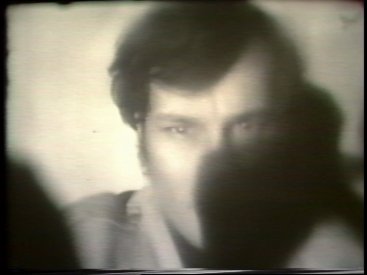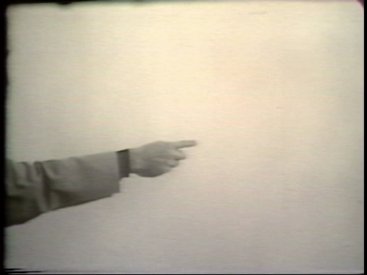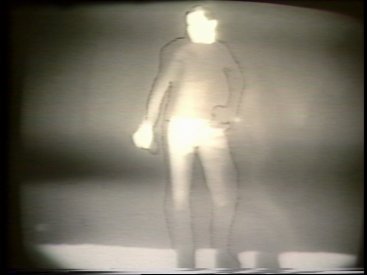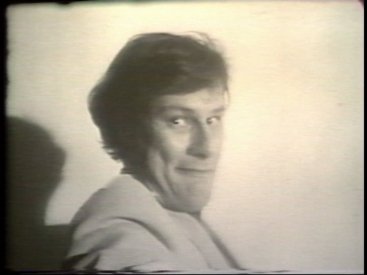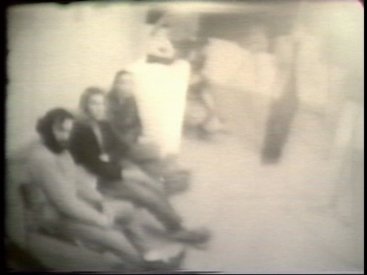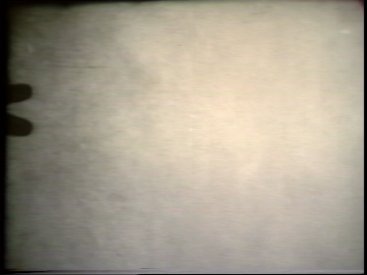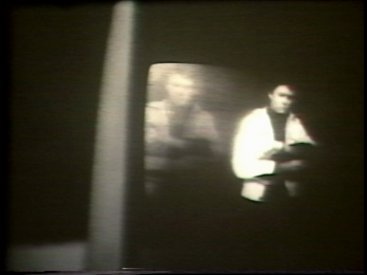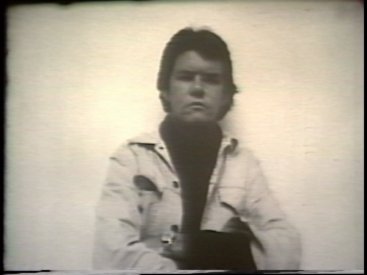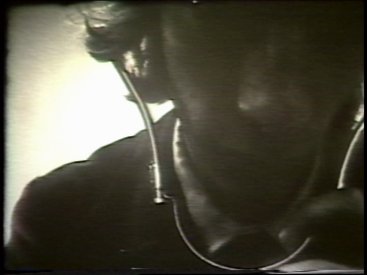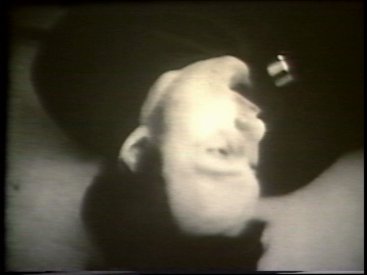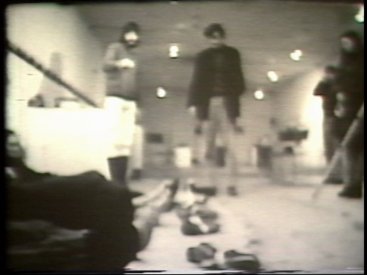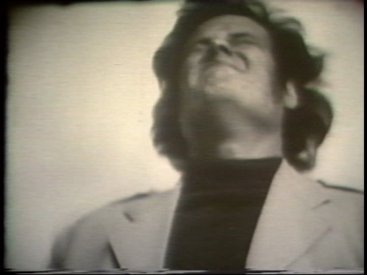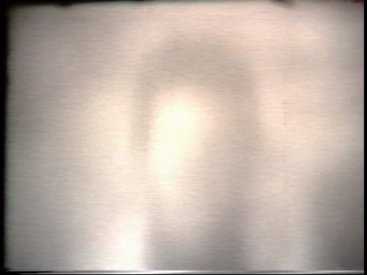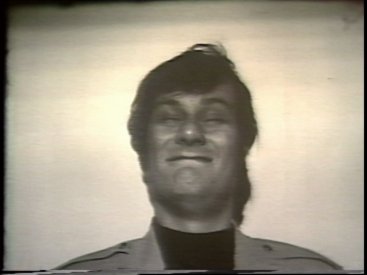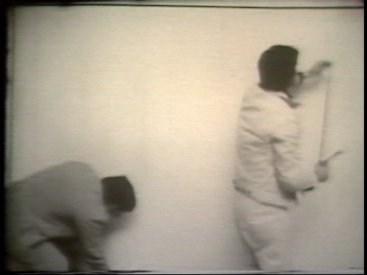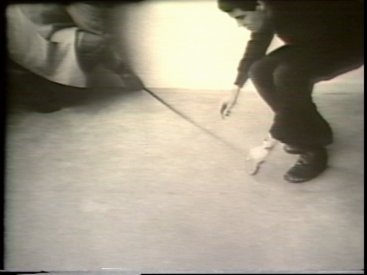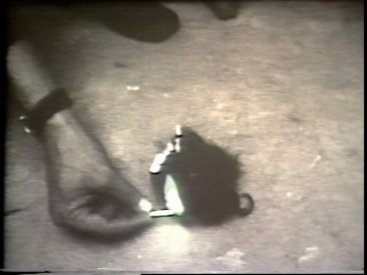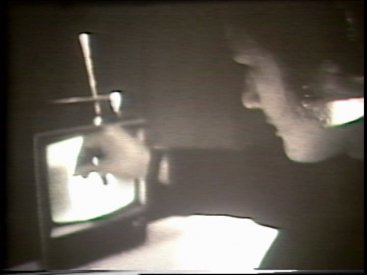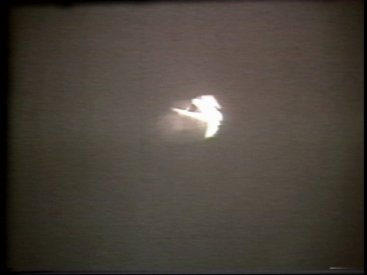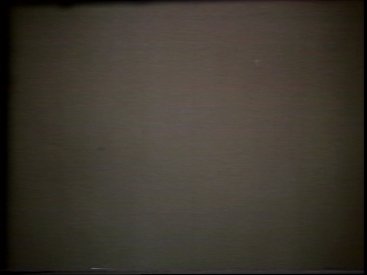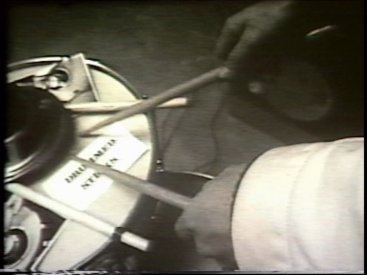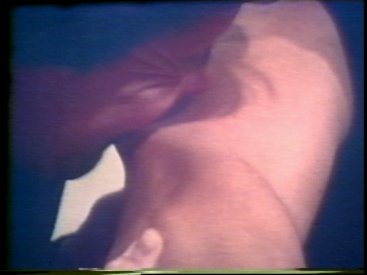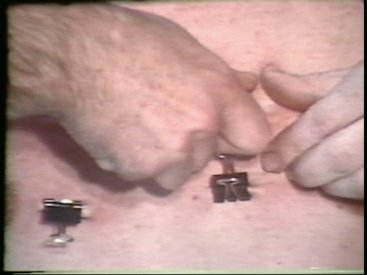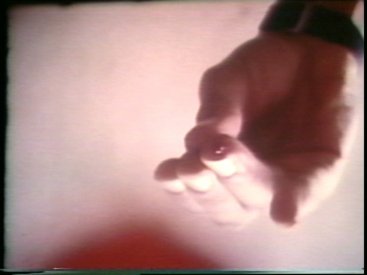Presented at Inhibodress as Trans Art 1: Idea Demonstrations.
Mike Parr and Peter Kennedy had been producing sets of instructions for performances, some of which could be realised. Parr’s set grew into the collection 150 Programs and Investigations, while Kennedy’s interest in sound and his experience in making But the fierce blackman led to his development of more instruction pieces for performance.
Part of the original motivation for wanting to record the performances with video was that they could record continuously for up to 20 minutes using the Akai tape machine. This was crucial to Parr’s and Kennedy’s durational performance works. As Parr notes, with the 100 foot rolls of film:
You could never do duration pieces. And what’s really interesting is that all these performances are using duration. The durational thing is really important, right from the beginning. That was what we were interested in. It was a crucial parameter in all this early work, and it’s remained very important too, because that’s how you could use the body with logical conviction, you know. Hold your breath for as long as possible, is sort of an existential unit, isn’t it, you know what I mean? Sit up and down as fast as you can and for as long as possible in front of a movie camera (from Idea Demonstrations). Or, bury your head in the ground, it’s again a breath work.
However, the videotapes produced for the Video Tapes at Inhibodress exhibition of late 1971 were not particularly successful, given the low technical quality of the image as recorded. Also it could be tricky to use, and the equipment failed for the replay on the first evening (23 November). Again, as Parr comments:
I can remember that the first video night was aborted. Peter and I were going to show these Akai tapes of the performances that we’d done mid 1971. And everyone turned up to Inhibodress. We couldn’t get anything up on the screen, on the monitor. I think then a fortnight later, or whenever it was, we came back together again and it all worked. Everyone was very tolerant and came back again.1
These factors led Parr and Kennedy to borrow a ½" Sony portapak from the University of Sydney to try to remake some of the works. This too did not work out and so it was decided to re-make everything on to film. They had met Albie Thoms during the Bruce Copping project and presumably met Aggy Read and Ian Stocks through Albie and his Ubu Films connections.
Idea Demonstrations is the result of this re-making. It consists of a combination of re-made versions of the works and entirely new ones. Many of the sequences included in the film show clearly that they were originally made on videotape and re-filmed from the screen, or in some other way demonstrate their having been made using the video screen.
Parr’s works are commonly durational, but more interestingly they invoke a non-linear duration, dragging the viewer’s subjectivity through a slow build-up that ends in an explosive moment of recovery — for example, in the sequence “Hold your breath for as long as possible”. The tension is palpable in Parr’s internal bodily tension as he fights the inevitable explosive intake of breath, and, in watching his shaking and almost popping eyes, the viewer finds himself holding one’s breath as well, in some kind of inescapable sympathy. Many of the works explore the constraints and possibilities of the screen’s boundaries and the more formal qualities of the video medium. Some of Kennedy’s performances also demonstrate a tension brought on through duress, while many of his sequences explore sound and the effects of producing what amounts to a body of solid noise.
Idea Demonstrations was recorded live in front of the audience that came to see the various events/works of Trans Art 1. It was subsequently presented as a single 16mm film made up from 24 sequences of recorded performances. Therefore, I will treat it as a single work here, while providing the instructions as published in an article by Donald Brook (1973).2. Several of the works were made with the assistance of a video camera and monitor, as indicated in the following list. Aggy Read and Ian Stocks operated the film camera, and provided lighting and other assistance for the filming of the works.
Idea Demonstrations:
A series of spontaneous events conceived and performed for camera and audience by Peter Kennedy and Mike Parr.
Sequence 1 [Indefinition Transference, performed by Mike Parr]
Place layers of cellulose tape over the lens of the camera … until no image can be defined through the camera. Seat a performer in front of the camera, about two feet from the camera. The performer should remove the cellulose tape from the camera, one layer at a time, until there is no more cellulose over the lens.
Technical instructions: The camera should be tripod-mounted and positioned about two feet from the performer. As the performer is positioned in front of the prepared camera, roll camera. Cease filming as all cellulose is removed from the camera lens.
No sound. Single take. No editing. b/w.
Kennedy comments: “There was that sense of revelation of something, a face, being revealed”3
Sequence 2 [performed by Peter Kennedy, instructed by Aggy Read]
The performer should stand just inside the periphery of vision of the camera, so that only the ends of his shoes are in frame. Responding to the instructions of the cameraman, the performer should move clockwise around the periphery of vision of the camera … until he arrives back at the point where he started.
Technical instructions: The camera and the cameraman should be positioned above the performer and the camera should be directed at the area of the floor where the performer is working. As the performer’s shoes come into frame, roll camera. The cameraman should guide the performer around frame with spoken instructions. Only the ends of the performer’s shoes should appear in frame. Cease filming as the performer arrives back at the point from which he started.
Optical sound. Single take. No editing. b/w.
Kennedy comments: “Here my feet move around the frame of the camera, and I think the camera, which was being operated by Aggy Read, was up near the ceiling. The camera operator was on a ladder looking straight down on the floor. The content, central to the meaning of the work was about the verbal instructions I was receiving from the cameraman to keep my toes, as they edged around the frame, just within the picture.”4
Sequence 3 [performed by Mike Parr]
By pointing at a white wall ... moving a finger over the wall, the performer should attempt to find the centre of frame.
Technical instructions: The camera should be tripod-mounted, and positioned about 10 feet in front of a white wall. The performer should be located in roughly the same plane as the wall and only his arm moving across the plane of the wall should be in frame. Roll camera as the performer is positioned. The performer should work blindly across the white wall trying to locate the centre of frame. When his finger moves to the centre of frame, the cameraman should acknowledge verbally, and filming should cease.
Optical sound. Single take. No editing. b/w.
Sequence 4 [NB: video used; performer 1: Aggy Read; drawing on video screen: Mike Parr; performer 2: Peter Kennedy]
The upright image of the performer is recorded by video camera while simultaneously being monitored on the video monitor. Draw around this image on the video monitor screen with felt pen. The person who drew this image should now replace the original performer in an attempt to fit himself into the drawn image on the video monitor screen.
Record all proceedings with film.
Technical instructions: Position the movie camera so that only the video monitor screen is recorded. As the video camera records performer 1, roll movie camera. All action, including the outlining of performer 1, should be filmed. Continue movie camera rolling, as performer 2 appears on the video monitor screen. Cease filming as the 2nd performer fits himself into the image on the video monitor screen. The movie camera should only record action on the VMS.
No sound. Single take. No editing. b/w.
Kennedy comments: “This is a sequence which, again, is about dialogue and communication, and might be likened to a metaphor for human society predicated on language. Aggy Read stood on a platform, where he was videotaped. We were using half-inch video equipment, borrowed from Sydney University. Mike draws an outline of Aggy, who adopted a pose — hands on hips, one leg slightly crooked. Mike draws his outline on the glass of the video monitor. Then following instructions, which are — you hear the directions on the soundtrack — I move in to Aggy’s outline and assume the same posture.”5
Sequence 5 [performed by Mike Parr]
Hold a movie camera at arm’s length ... until the camera falls from your grip.
Technical instructions: Roll camera as the performer raises the camera to shoulder height at arm’s length distance from his face. Throughout the work, the performer should try to hold his face in frame. Filming will cease as the camera falls away from the performer’s face.
No sound. Single take. No editing. b/w.
Sequence 6
Use a movie camera to measure the height of a room.
Technical instructions: Attach a long cord to the camera. Pass this cord over any beam or rafter located at ceiling height in the room. As the camera is raised gently from the floor, roll camera. The camera should be pulled up gently to the height of the roof and then lowered back down to the floor. Cease filming as the camera touches the floor.
No sound. Single take. No editing. b/w.
Sequence 7 [NB: video used, performed by Peter Kennedy]
The performer should stand alongside a video monitor.
Both a movie camera and a video camera should record the performer’s image as he moves from left to right and right to left creating after-images on the video monitor screen.
Technical instructions: The video monitor should be positioned at chest height, facing both the movie camera and the video camera which both point at the video monitor screen. The performer should be positioned standing on the right side of the monitor. Roll cameras. As the performer moves from right to left, he will move into the vision of the video camera and his image will be recorded. As he again moves from left to right, this time his image will linger on the monitor screen. These moves, from right to left and then from left to right, should become progressively more rapid until the performer abruptly stops. Cease all filming.
No sound. Single take. No editing. b/w.
Kennedy comments: In this piece “I interact with my after-image, and one of the characteristics of early video was the fact that if you positioned a still object long enough it would burn into the tube — the retina of the camera —and leave a ghostly after-image. In this piece ... we were filming the monitor, and I move outside of my ghosted image and back into it in either decreasing or increasing intervals of time. I can’t remember which way it went. This piece was a bit like where I fit into the image of Aggy Read being drawn on the screen of the video monitor.”6
Sequence 8 [performed by Peter Kennedy]
Stare at the lens of a camera ... periodically close your eyes in an effort to achieve an after-image.
Technical instructions: The camera should be located immediately in front of the performer and should be tripod mounted. As the performer begins to stare into the lens, roll camera. From time to time, the performer will simply close his eyes as he attempts to establish an after image. As an after image is achieved, the performer should discretely signal the cameraman and filming should cease.
No sound. Single take. No editing. b/w.
Kennedy comments: “I [had] worked on the sequential arrangement of my pieces, I can see, looking at this layout7 that [immediately] after that action8 I stand directly facing the camera with my arms crossed … and open and close my eyes. What I try to induce is a retinal ghosting of Aggy Read and the camera, who are the subjects of my gaze. But you’d have to be paying a lot of attention or thinking very deeply about all of this to see the logic, the connections or the relationships. But that, in a sense, didn’t really matter.”
Sequence 9 [performed by Ian Stocks?]
A performer should use a stethoscope to map the motor sound of the camera.
As this is accomplished, the performer should attach the transmission tips of the stethoscope to a microphone and continue mapping the sound of the camera.
Technical instructions: Tripod mounted camera. As the performer moves in close to the lens of the camera with microphone, roll camera. The camera should record both phases of work: as the performer maps and listens to the camera motor and as the performer transmits this amplified camera sound to the microphone. Cease filming as the performer moves the sensor disk of the stethoscope to fill the lens of the camera.
Optical sound/full volume. Single take. No editing. b/w
Sequence 10 [peformed by Mike Parr]
The performer should lie on his side on the floor.
Holding a microphone to his mouth he should hold his breath ... until he is forced to break.
Technical instructions: Train the camera on the performer’s face as he lies on the floor. Roll camera as he completes inhalation. Cease filming as he breaks for breath. Record all sound at maximum volume.
Optical sound/full volume. Single take. No editing. b/w.
Sequence 11 [director: Peter Kennedy, string raised and dropped by Mike Parr]
Six performers lie on the floor in a row.
The director tapes over their mouths — he writes on the tape their answer to the question: ‘Do you object to this action? Yes or no.’ The performers’ shoes are removed, taped to a string, raised in the air and dropped.
Technical instructions: The cameraman records the action at will. As the shoes are dropped filming should cease.
Optical sound/full volume. Single take. Editing. b/w.
Kennedy comments: This was “a sound piece, [it] involved a number of people lying on the floor, which introduces an element of vulnerability. ... Tim [Johnson] would’ve shown me the photographs at the time he made [Disclosures]. … And when I saw that work again after 40 years,9 I thought how much it reminded me of this piece where various people, including Terry Smith, lie on the floor and I run adhesive tape across their mouths, not dissimilar to something I’d done earlier in the 1971 videos with David Ahern in a piece called For Silence Do Not Take Chances,10 which referenced John Cage’s idea of silence, and chance via the I Ching — two of Cage’s big ideas. But the way that I had the participants lie on the floor, and their consequent vulnerability, reminded me very much of Tim’s work. And it occurred to me that I may well have been influenced by Tim’s work when I set that piece up.
However, I was aiming at something that was intended to be completely meaningless, and incorporating a sound component that aspired to a similar status. Once positioned on the floor, the participant’s shoes were removed, tied to a long piece of string, and the string, with shoes attached, held above their feet and dropped with a bang on the floor. My recollection is that it was an attempt to do something that was as remote from meaning as could possibly be achieved at that time. That was the challenge, the idea of the impossibility of the meaningless. How hard might it be to push beyond interpretation?”11
Sequence 12 [peformed by Mike Parr]
Sit up and down as fast as possible.
Continue until exhausted.
Technical instructions: The camera should be tripod mounted and located immediately in front of the performer. As the performer begins sitting up and down — bending forward, bending back down to the floor over the seating box, bending forward, at max. speed — roll camera. Cease filming as the performer slows to a stop.
No sound. Single take. No editing. b/w.
Sequence 13 [Indefinition Transference, performed by Peter Kennedy]
A performer, seated in front of a camera, should, by placing strips of cellulose over the lens of the camera, progressively obliterate his image, until the camera records no image at all.
Technical instructions: camera, tripod mounted, should be positioned about 2 feet from the performer, so that only his head is in frame. Roll camera as the performer commences to tape out his image. Cease filming as the performer’s image is totally obliterated.
No sound. Single take. No editing. b/w.
Sequence 14 [performed by Mike Parr]
Stare at strong light without blinking.
Technical instructions: Tripod mounted camera positioned in front of performer’s face. A strong light should be projected from behind camera on to performer’s face. Begin filming as the performer stares at the light. Cease filming as soon as he blinks.
No sound. Single take. No editing. b/w.
Sequence 15 [performed by Mike Parr and Peter Kennedy, instructed by Aggy Read]
Two performers, working to instructions from the cameraman, tape a square on to a white wall, in accordance with the periphery of vision of the camera.
Technical instructions: Tripod mounted camera positioned in front of a white wall. Roll camera as the two performers enter frame and begin aligning black masking tapes with the periphery of vision of the camera. The performers should place tapes on the wall in accordance with the instructions given by the cameraman. Filming should cease as the square is constructed.
Optical sound. Single take. No editing. b/w.
Sequence 16 [performed by Mike Parr and Peter Kennedy, instructed by Aggy Read]
Two performers, working to instructions from the cameraman, align a tape, running diagonally down the wall, from the top left-hand corner of the camera frame with a point out from the wall and on the floor which corresponds with the lower, right-hand corner of the camera frame. Having laid down this tape, the performers, working with instructions from the cameraman, manipulate the angle of this tape to wall and floor to make a diagonal tape line stretching across the frame.
Technical instructions: The camera should be tripod mounted and positioned in front of the wall, so that ⅓ of the frame is filled with wall while the remaining ⅔ is filled with floor. As the performers enter frame, roll camera. Filming should cease as the performers establish the diagonal and leave frame.
Optical sound. Single take. No editing. b/w.
Kennedy comments: “There was another performance piece a bit like this — it must have followed on from the sequence of my feet moving around the edge of the camera — that described, using a piece of black tape, a diagonal line running from the top left hand corner of the frame of the camera, down to its bottom right hand corner, making the necessary perspectival compensation at the junction of the wall and the floor, so visually you see only a straight line. Again, my idea there was [that] this was metaphorical, in the sense that it posited dialogue as being integral to construction and production. That is, the dialogue resulted in an outcome, which was this illusion of a straight diagonal line.12
Sequence 17 [performed by Mike Parr]
Burn some hair from your body in a closed room.
Technical instructions: Using a hand-held camera, roll film as the performer’s hair is cut. Filming should continue without interruption as the hair is swept into a heap and set alight. Cease filming as all hair is burnt.
No sound. Single take. No editing (ideally). b/w.
Sequence 18 [NB: video used, performed by Mike Parr]
Using a video camera, the performer’s face should be recorded and played back simultaneously on the video monitor. As the video monitor records the image the performer should endeavour to erase the eyes of the image by applying successive layers of cellulose tape to the monitor.
Technical instructions: The movie camera, tripod mounted, should be positioned in such a way that both the screen of the monitor, and the performer in profile, are recorded by the camera. Roll film, as the performer begins applying tape to the monitor. Cease filming when the eyes of the face on screen are obliterated.
No sound. Single take. No editing. b/w.
Sequence 19
Use a camera to record the outline of a performer’s body.
Technical instructions: The vision of the camera lens should be substantially reduced with masking tape. Using a hand-held camera, the cameraman should systematically travel around the edge of the performer’s body, so that only the extreme edges of the body are recorded.
No sound. Single take. No editing. b/w.
Kennedy comments: “This one here ... is interesting in the sense that it’s a take-off of the preceding year’s ¼" video performance — the Barbara Hall-Peter Kennedy Body Concert, with the microphone.13 … But with this piece here ... the camera lens was taped up, leaving a small aperture, and it’s that pin-holed aperture that traces the outline of the body. And that goes back to the drawing of the outline here,14 the edge of some section of clothing ... it goes straight back to that. But it is also an introduction to the idea which follows this drawing of the body by camera [see Sequence 20], where the activity is repeated — again it’s a drawing of the outline of the body, but in this instance it’s the microphone that’s lightly moved all the way up around the body.”15
Sequence 20
Use a microphone to record the sonic content of the performer’s body outline.
Technical instructions: Using a sensitive microphone, record a sonic diagram of the performer’s body, by running the microphone around the edge of the performer’s body. This block of sound should be used in the film, in conjunction with black spacing.
Kennedy continues: “So this sequence is all black, you just hear a lot of sounds, which is the microphone moving across different surfaces: trousers, shirt, hair or face or skin.”16
Sequence 21 [Drummed Sticks, performed by Peter Kennedy]
Activate SNARE, a sound installation using drums.
Record both the performing technician and the installation sound.
Technical instructions: The cameraman should record the technician as he moves to activate the installation, and as he holds two vibrating sticks (Drummed Sticks) to the skins. Cease filming. Record 4 minutes of sound.
Optical sound/full volume. Editing. b/w.
Kennedy continues: “And then in the next sequence we move to this sonic barrage, which is derived from the SNARE installation, and resembles my taking on of the meaningless, as with the shoes suspended and dropped at the feet of those from whom the shoes had been removed. This is simply noise, and defies interpretation; another exercise in creating something meaningless. It’s also a meaninglessness which is less than pleasant. It’s titled Drummed, D-r-u-m-m-e-d, Sticks, and it was drawn from the sound installation SNARE. I’m holding the drumsticks, and the sticks, because of the volume of sound that’s put through the drums via the speaker, actually vibrate my hands. So I’m the drummed, rather than the drummer, I guess, so there’s a reversal of expectation. A lot of the work I was concerned with at this time was about this — there’s been occasions since then, and even recently —where normal expectations are reversed in some way, that what one might normally expect is turned around so that another kind of understanding is introduced. The original idea is the medium that delivers us to a different construction of our original expectation.”17
Sequence 22 [performed by Mike Parr and Peter Kennedy] Sitting before an audience bare your shoulder.
Let a friend bite into your shoulder ... until blood appears.
Technical instructions: The camera should be tripod mounted and positioned to record the actual biting of the arm. Roll camera as the arm is bitten into. Cease filming as the performance is completed.
No sound. Single take. No editing. Colour.
Sequence 23 [Tension, performed by Peter Kennedy]
Put steel clips on to a bare chest.
Continue putting clips on and squeezing them off, until the flesh is lacerated and too sore to continue the work.
Technical instructions: The camera should be tripod mounted and positioned to record the clips going on and coming off the chest. Cease filming as the work is complete.
No sound. Single take. No editing. Colour.
Kennedy comments: “This is the Tension piece, originally recorded on ¼" videotape the year before but done for colour 16mm film. So I went from the black and white video to 16mm film, and that seemed to have a direct relationship to what was going to on. But we see this in ‘technicolour’. We can see the fluid, the moisture seeping out of the skin after the clips were popped off and we see the weals as they get redder. So this is the piece that leads me to consider an alternative approach. This idea of reinforcing the viewer’s self-identity or self-awareness. An art that facilitates action in the context of political change or social transformation.”18
Sequence 24 [performed by Mike Parr]
Drip blood from your fingers on to the lens of a camera ... until the lens is filled with blood.
Technical instructions: The camera should be tripod mounted and positioned in such a way that it points upwards toward the sky or ceiling. The performer should position his hand above the lens, so that the image of his hand fills the frame. Roll camera. An assistant’s hands should appear above the camera and a scalpel used to incise the performer's finger. Blood will drip on to the lens. After the lens has been filled with blood, and only redness is being recorded, continue filming for 2½ minutes as the lights shift behind the red field.
No sound. Single take. No editing. Colour.
- 1. Mike Parr, conversation with Stephen Jones, recorded 26/08/10.
- 2. Donald Brook, “Idea Demonstrations: ‘video freaks’ in Sydney”, Studio International, Vol. 185, No. 956, June 1973, pp. 269–273.
- 3. Peter Kennedy, conversation with Stephen Jones, recorded 16 September 2010.
- 4. Ibid.
- 5. Sequence 7
- 6. Peter Kennedy, conversation with Stephen Jones, recorded 16 September 2010.
- 7. Ibid.
- 8. The layout of the sequence in Donald Brook, “Idea Demonstrations: ‘video freaks’ in Sydney”, Studio International, Vol. 185, No. 956, June 1973, pp. 269–273.
- 9. Tim Johnson’s exhibition at the Ian Potter Museum of Art, University of Melbourne, November 2009.
- 10. Video Tapes at Inhibodress.
- 11. Peter Kennedy, conversation with Stephen Jones, recorded 16 September 2010.
- 12. Peter Kennedy, conversation with Stephen Jones, recorded 16 September 2010.
- 13. Video Tapes at Inhibodress.
- 14. Sequence 4.
- 15. Peter Kennedy, conversation with Stephen Jones, recorded 16 September 2010.
- 16. Ibid.
- 17. Peter Kennedy, conversation with Stephen Jones, recorded 16 September 2010.
- 18. Peter Kennedy, conversation with Stephen Jones, recorded 16 September 2010.
